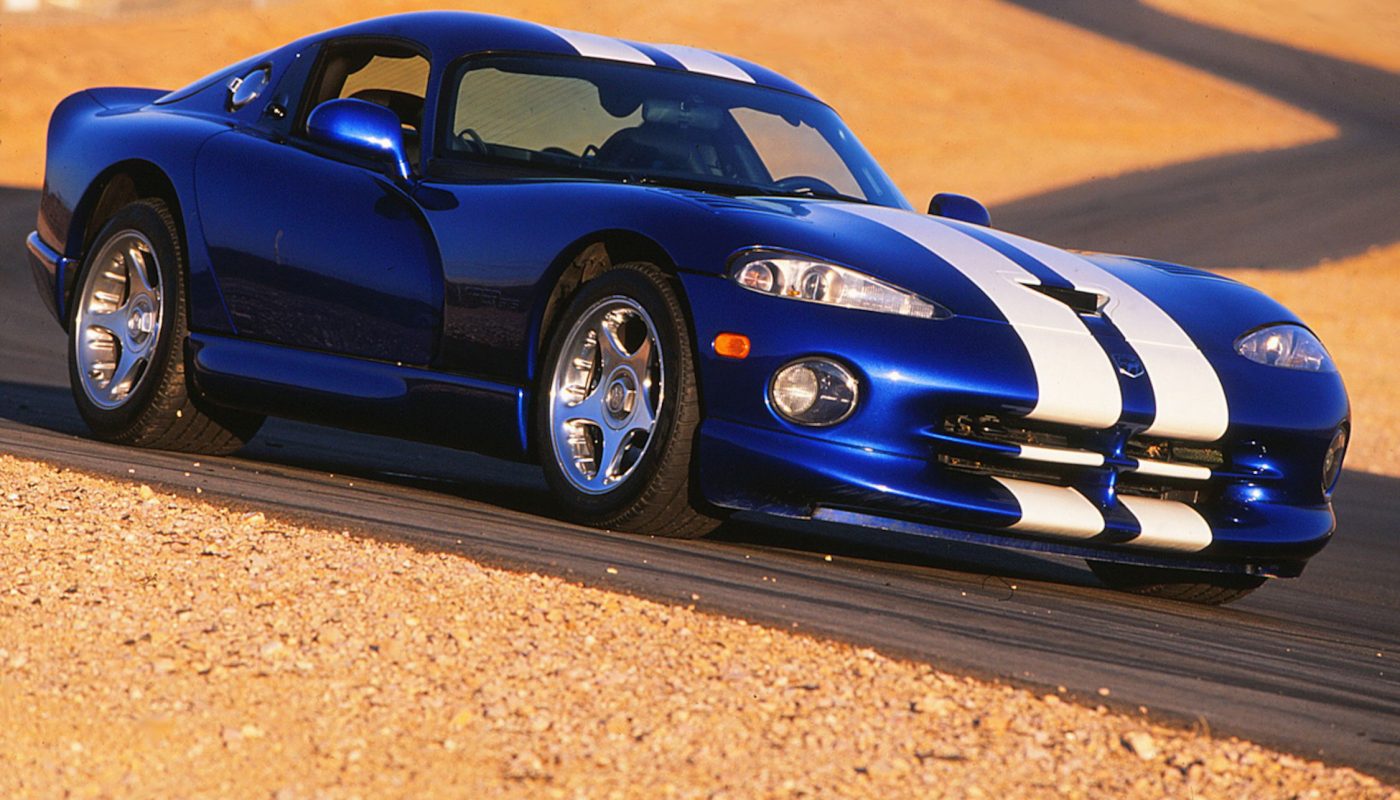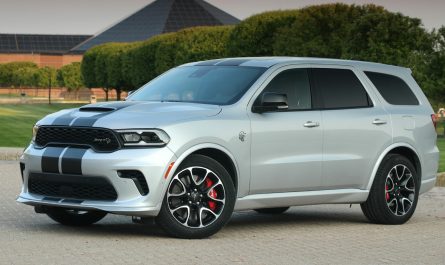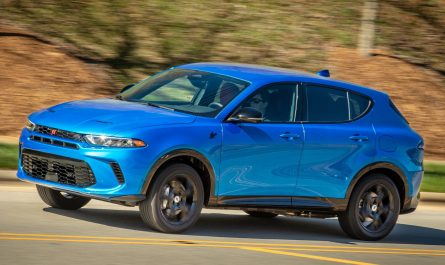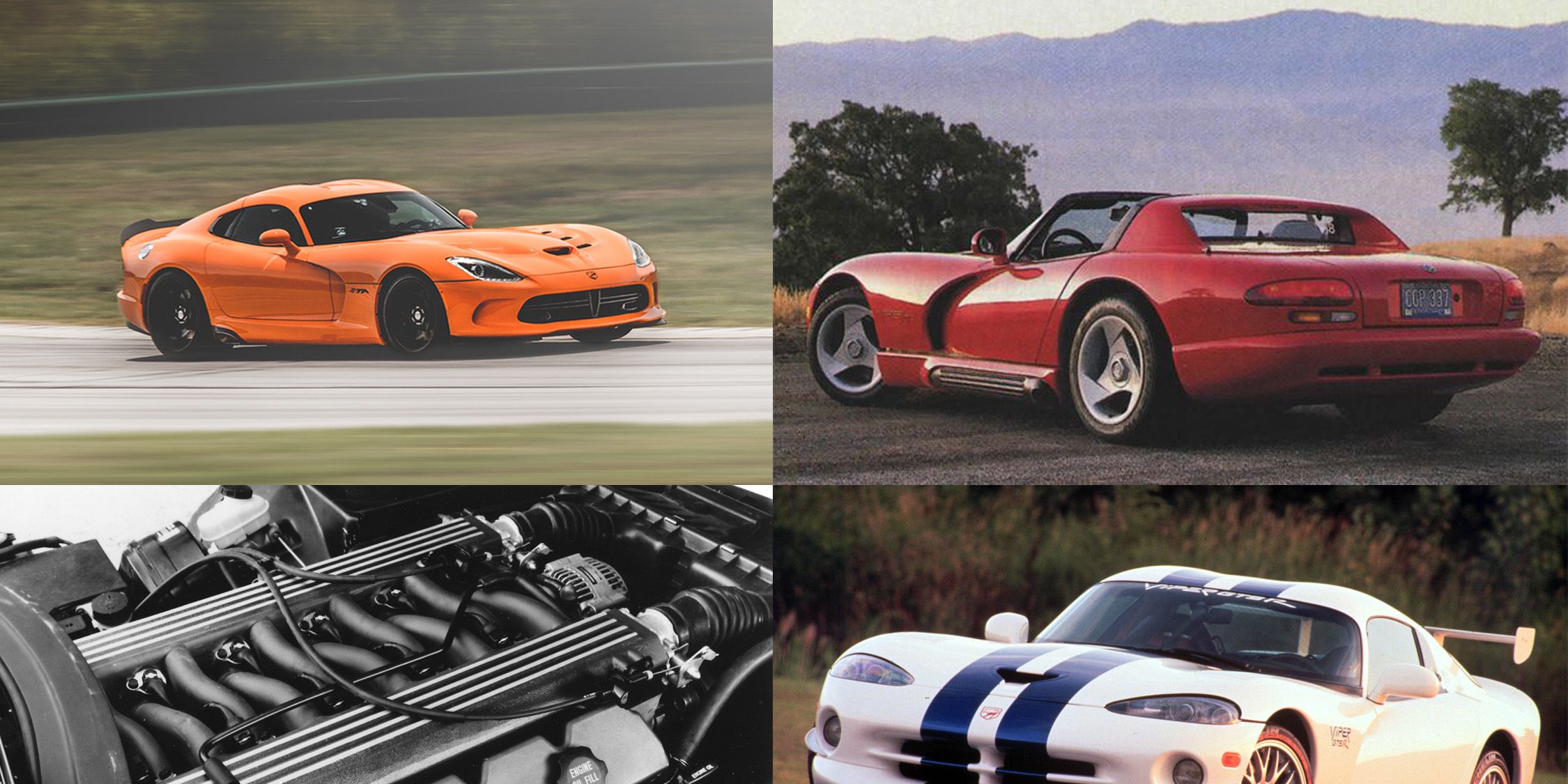
Car and Driver
The Dodge Viper began as a twinkle in the eye of Bob Lutz, who was then Chrysler’s president of operations, in 1988. His big-ticket idea started with a question: What if the American automobile manufacturer built a sports car in the vein of the original Shelby Cobra? Lutz wanted a Chrysler with raw performance, plentiful power, and salacious looks.
Lutz figured Chrysler had all the tools needed to swiftly craft such a vehicle, in particular a V-10 engine that was being developed for the heavy-duty Dodge Ram pickup truck. Meanwhile, suspension parts from the smaller Dakota (also a pickup) could help keep costs down. Upon hearing about Lutz’s idea, lead truck engineer François Castaing and Chrysler designer Tom Gale were sold on the project. Later, Carroll Shelby, the man behind the original Cobra, joined in to parrot the premise of a Cobra-inspired Chrysler to CEO Lee Iacocca. The project was given the green light and turned around remarkably quickly, with a concept car arriving within months.
A shoestring budget—at least by major automaker standards—of approximately $80 million brought the Viper to life. It was flawed, it was striking, and it immediately caused a sensation, and the model’s notoriety spurred Chrysler to keep the nameplate around until 2017. Click through to see highlights of the Viper’s history.

Aaron Kiley Car and Driver
1of 22
First Bite
Dodge unveils the Viper concept at the 1989 Detroit auto show. With the forthcoming V-10 still in development, the concept car’s engine is a prototype ten-cylinder built from a pair of V-8s. (According to Lutz’s book Guts, the V-10 was “created by welding six cylinders of one V-8 block to four cylinders of another!”) The concept is met with immediate fanfare, and Iacocca tells the Viper team to “Go build it!” The team digs further into developing the sports car, and two prototypes are built. One has a V-8 engine and a second uses the V-10. Both cars wear bodywork almost identical to that of the concept car, although it is the ten-cylinder car that graces the cover of our October 1990 issue.
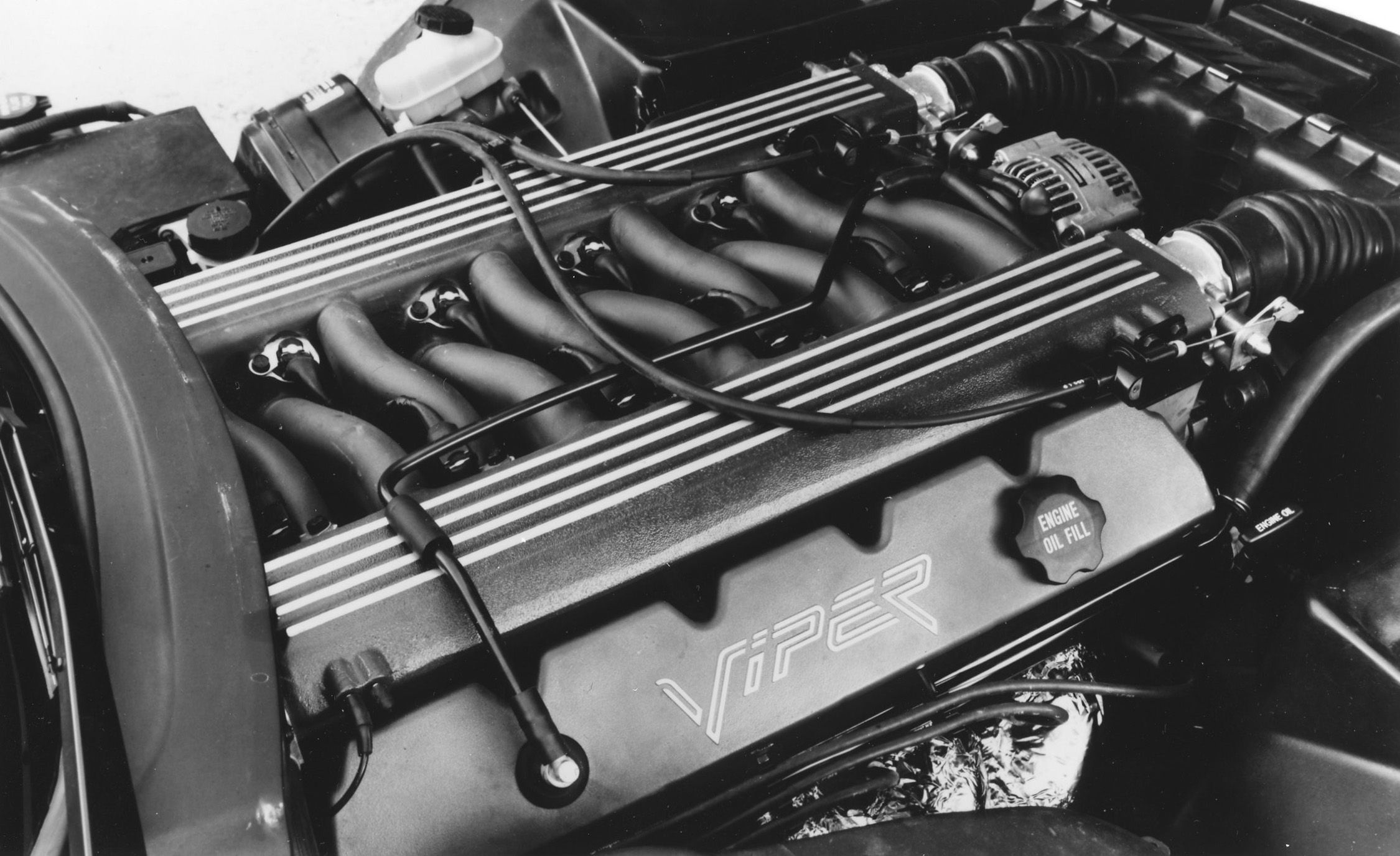
2 of 22
Don’t Truck with Us
Dodge looks to Lamborghini, then a corporate affiliate, to help adapt the Ram’s V-10 engine for use in the Viper. Most notably, the truck engine’s iron block is traded for a lighter aluminum block, helping reduce the engine’s weight by 160 pounds. Lamborghini’s influence lies almost exclusively in the photogenic outward appearance of the Viper’s engine. When all is said and done, the two V-10s are essentially unrelated. Still, it’s fun to refer to the Viper as having a truck engine.
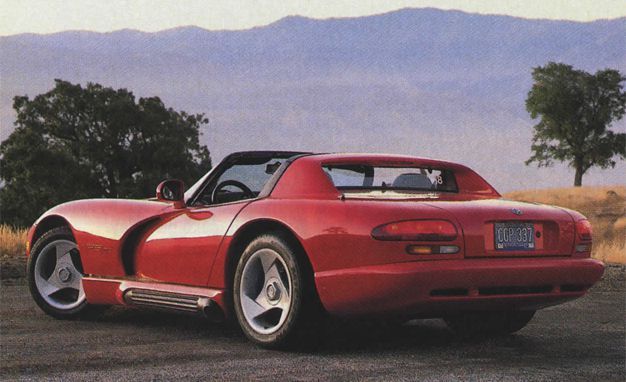
Rick Case more Car and Driver
3 of 22
Finally, It’s Real
Dodge pulls the cover off the production Viper RT/10 at the 1992 Detroit auto show, three years after first showing the concept. The car is as raw as a modern vehicle could be, just as the Shelby Cobra that inspired it was in the 1960s. Most aspects of the Dodge two-seater seem designed to force comparisons to that classic Shelby: The Viper lacks door-mounted windows and exterior door handles but does have side-exit exhaust outlets. When the engine is running, these cool-looking pieces heat up the doorsills they sit beneath so much that passengers could scald uncovered flesh when clumsily entering or exiting the car.
The roof, such as it is, is a thin cloth thing with metal ribs barely supporting its span. And the driver must contend with the clutch, brake, and gas pedals being offset significantly to the left of the driver’s seat, a necessary concession to the huge 400-hp 8.0-liter V-10 engine and six-speed manual gearbox hogging space in the middle of the chassis. Almost immediately, the car gains a reputation for hairy handling, a hot and uncomfortable cabin, and general grittiness. These revelations seem to only enhance the car’s appeal. In our July 1992 issue,we drive a Viper alongside a brand-new Cobra 427SC continuation car and find them both to be irresistible.
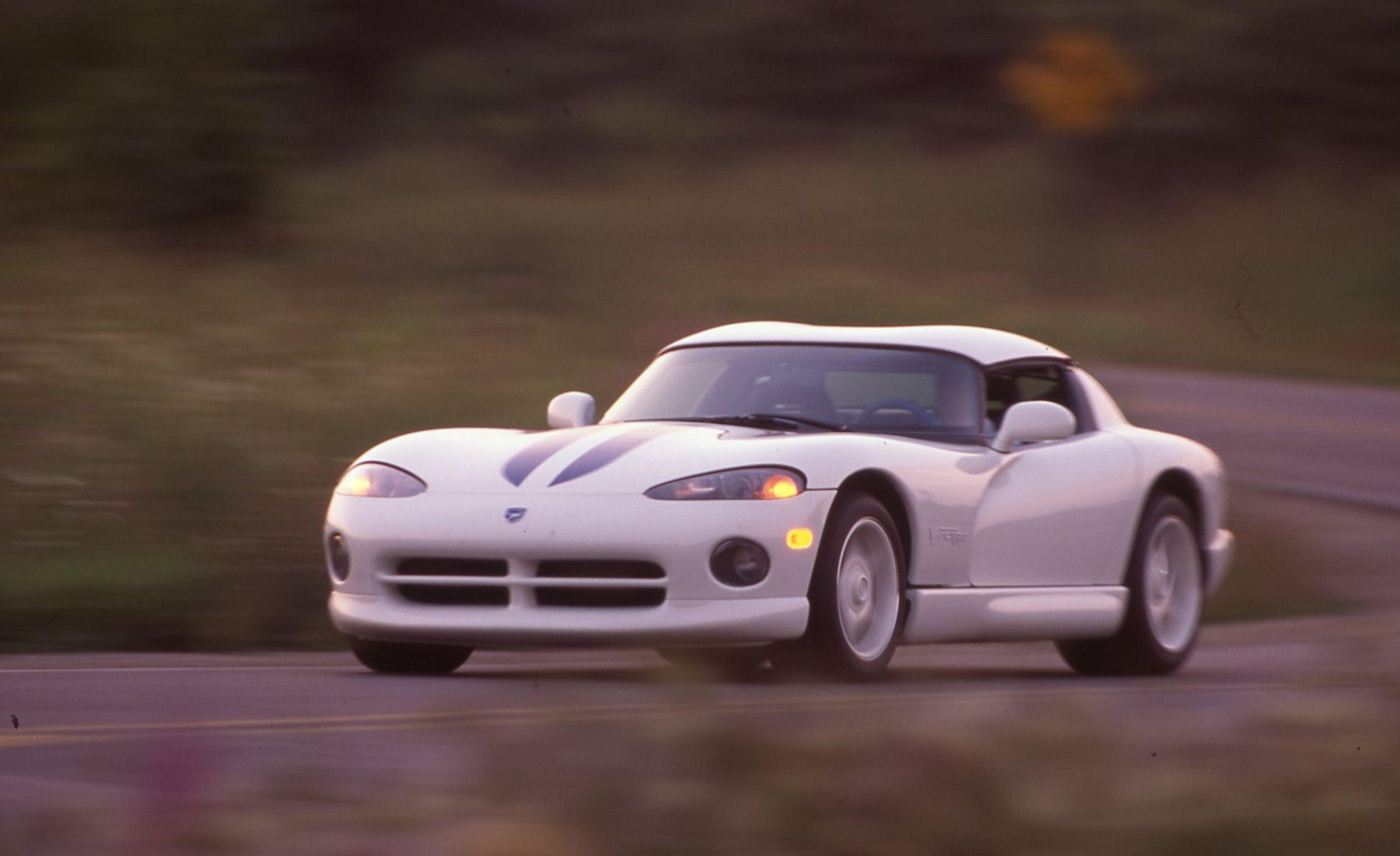
4 of 22
Ch-ch-ch-ch-changes
EPA requirements force Dodge to abandon the Viper’s infamous, leg-cooking side pipes for 1996. The new rear-exit exhaust piping improves the raucous roadster’s roar and adds 15 horsepower to the 10-cylinder engine’s output. Dodge rests the Viper’s seductive body on a stiffer new frame. The brand also replaces a number of steel suspension pieces with lighter cast-aluminum parts, shedding 60 pounds of unsprung mass. New five-spoke wheels take the place of the prior three-spoke units, and a removable hard top is added to the options menu.
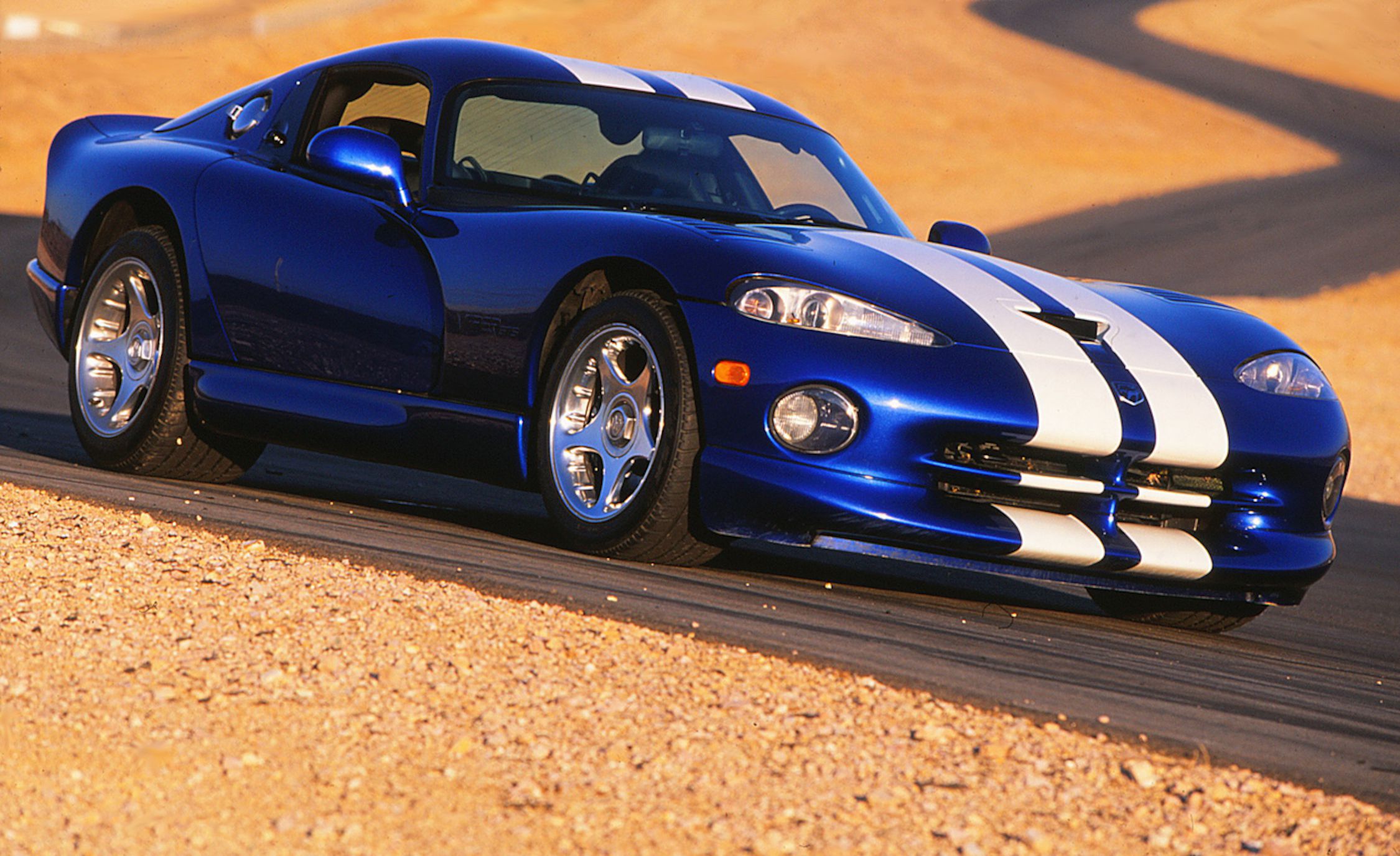
Rich Chenet Car and Driver
5 of 22
GT YES!
Model year 1996 also welcomes the slightly more civilized Dodge Viper GTS coupe to the lineup. Civilized is, of course, a relative term, and the fastback model remains as rambunctious as the roadster. Higher compression, a revised cooling system, and changes to the intake and exhaust ports help increase the coupe’s output to 450 horsepower. The GTS also includes a revised interior with power windows, driver and passenger airbags, and adjustable pedals. Door handles are added to the exterior, as well. The GTS’s array of performance and convenience features find their way to the Viper RT/10 droptop in 1997. We clocked four different 450-hp Vipers at 4.0 seconds in the zero-to-60-mph sprint and one at 3.9 seconds—incredibly consistent figures that place them among the quickest cars of the decade.
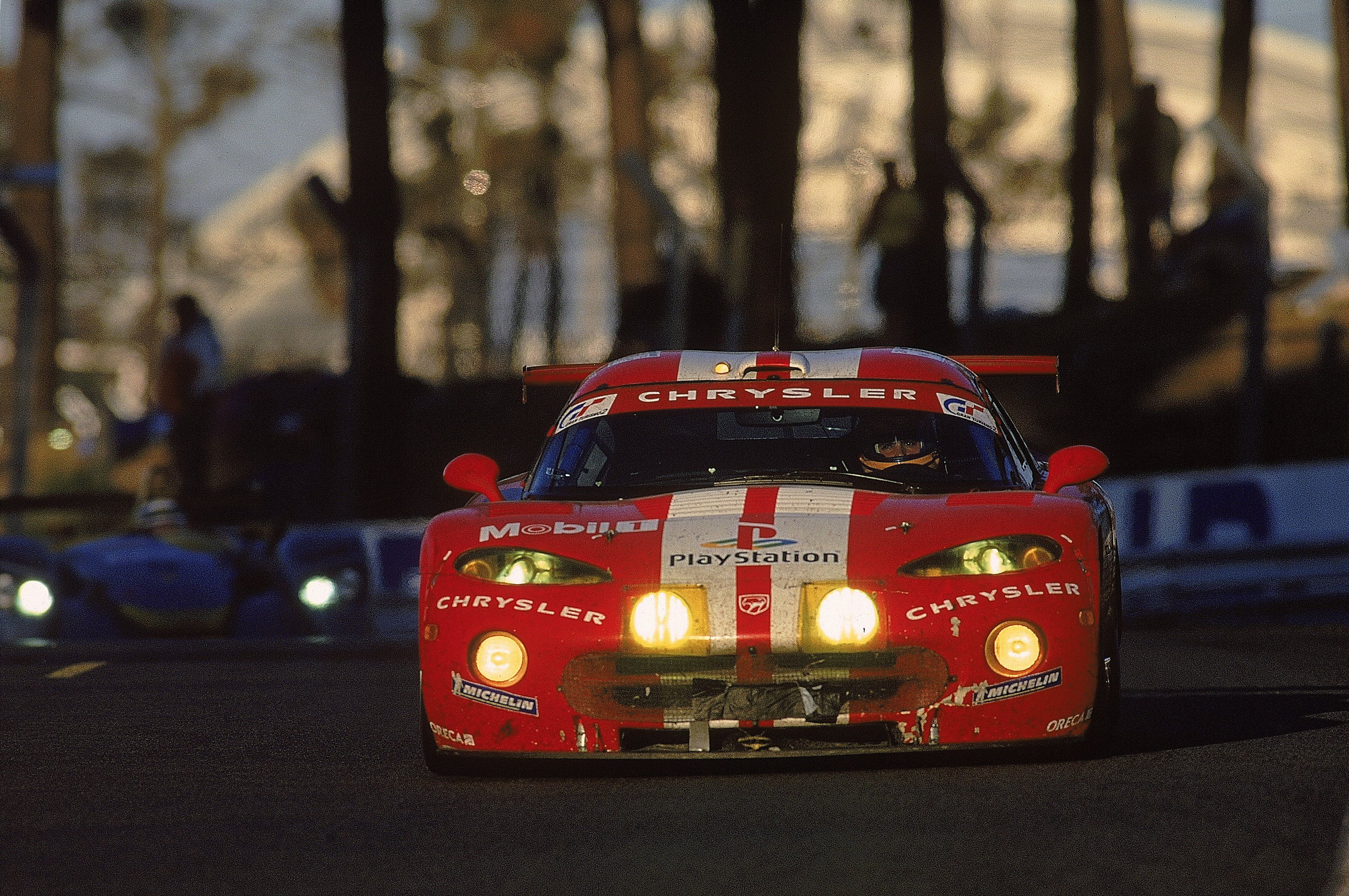
Getty Images / Ker Robertson Car and Driver
6 of 22
Rubbing Is Racing
At the 1998 24 Hours of Le Mans, two Viper GTS-R race cars finish first and second in their class. The following year, a sextet of these Vipers nab the top six spots in their class. The champagne continues to flow in 2000, as Vipers take home the overall win at the 24 Hours of Daytona, sweep the GTS class podium at the 12 Hours of Sebring, and claim first and second place in their class at Le Mans (pictured).
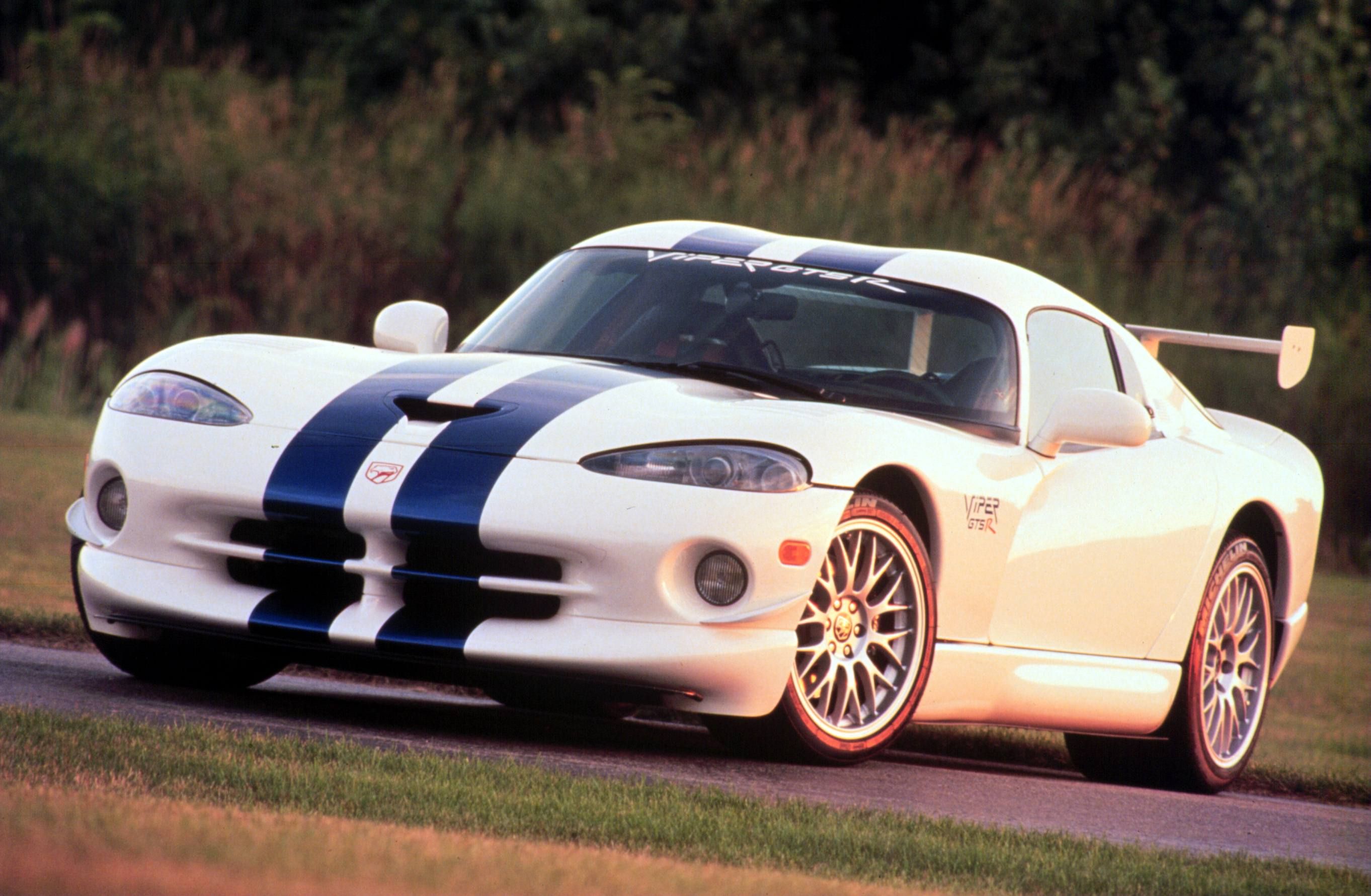
7 of 22
Race on Sunday, Sell on Monday
Dodge celebrates the racing success of the Viper with a special-edition model. The 1998 Dodge Viper GT2 sports a massive rear wing and other aerodynamic additions inspired by the GTS-R race car. A total of 100 are built, and an improved air-filter design is good for an extra 10 horsepower, for a total of 460.
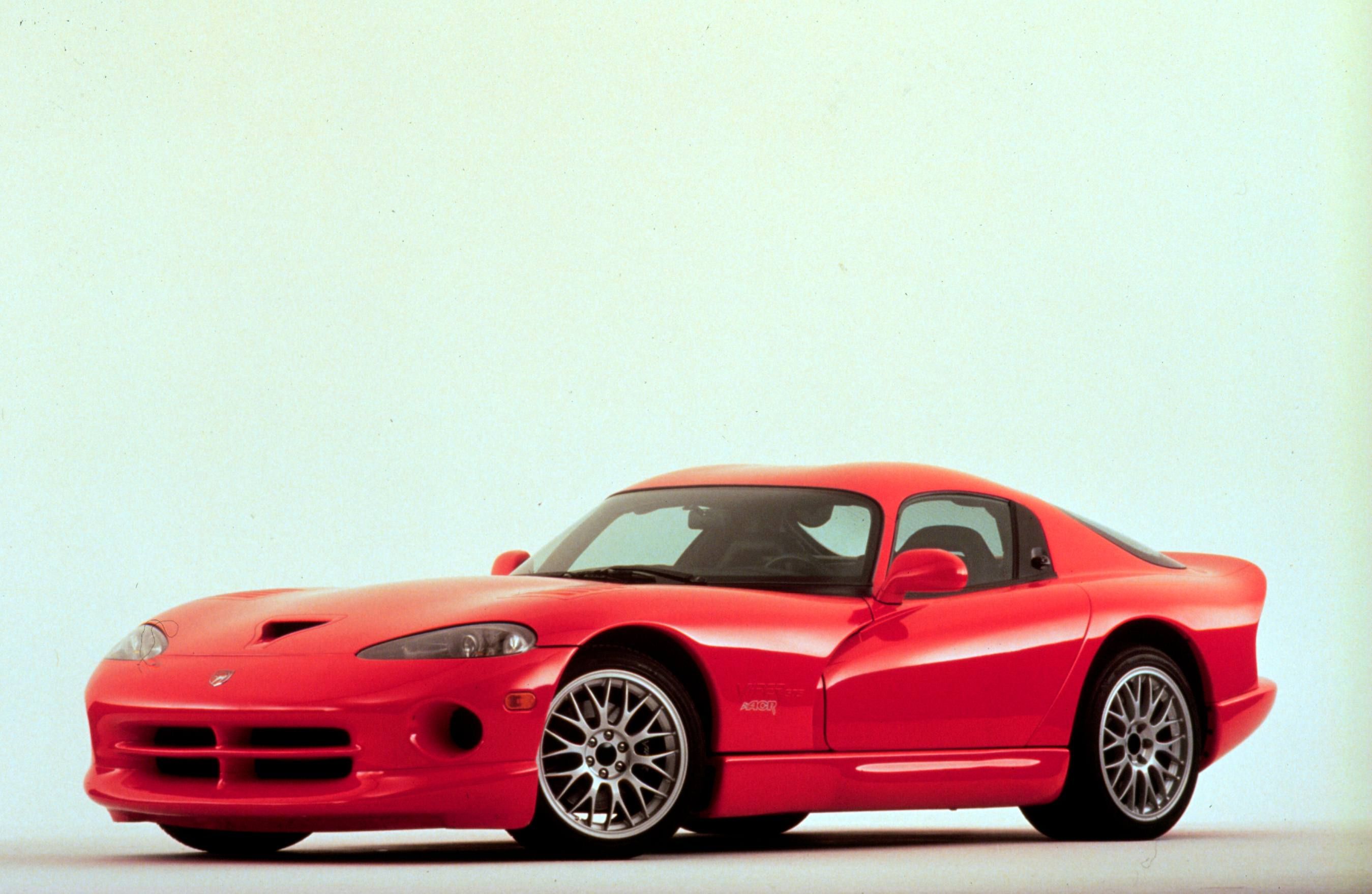
8 of 22
ACR Asp
Dodge adds the Viper ACR to the mix for the 1999 model year. The option costs $10,000 on top of the regular Viper’s price and deletes the stereo, air conditioning, and fog lights. The ACR also includes the GT2’s 460-hp engine tune.

9 of 22
Spittin’ Venom
Eleven years after the debut of the Viper concept, Dodge pulls the wraps off the Viper GTS/R concept at the 2000 Detroit auto show as a preview of what’s next. Like the original car, the GTS/R concept is motivated by a huge front-mounted V-10 engine. Shifting duties are handled by the driver via a manual transmission. Dodge claims the sports car is capable of 200 mph and an 11.8-second quarter-mile time.
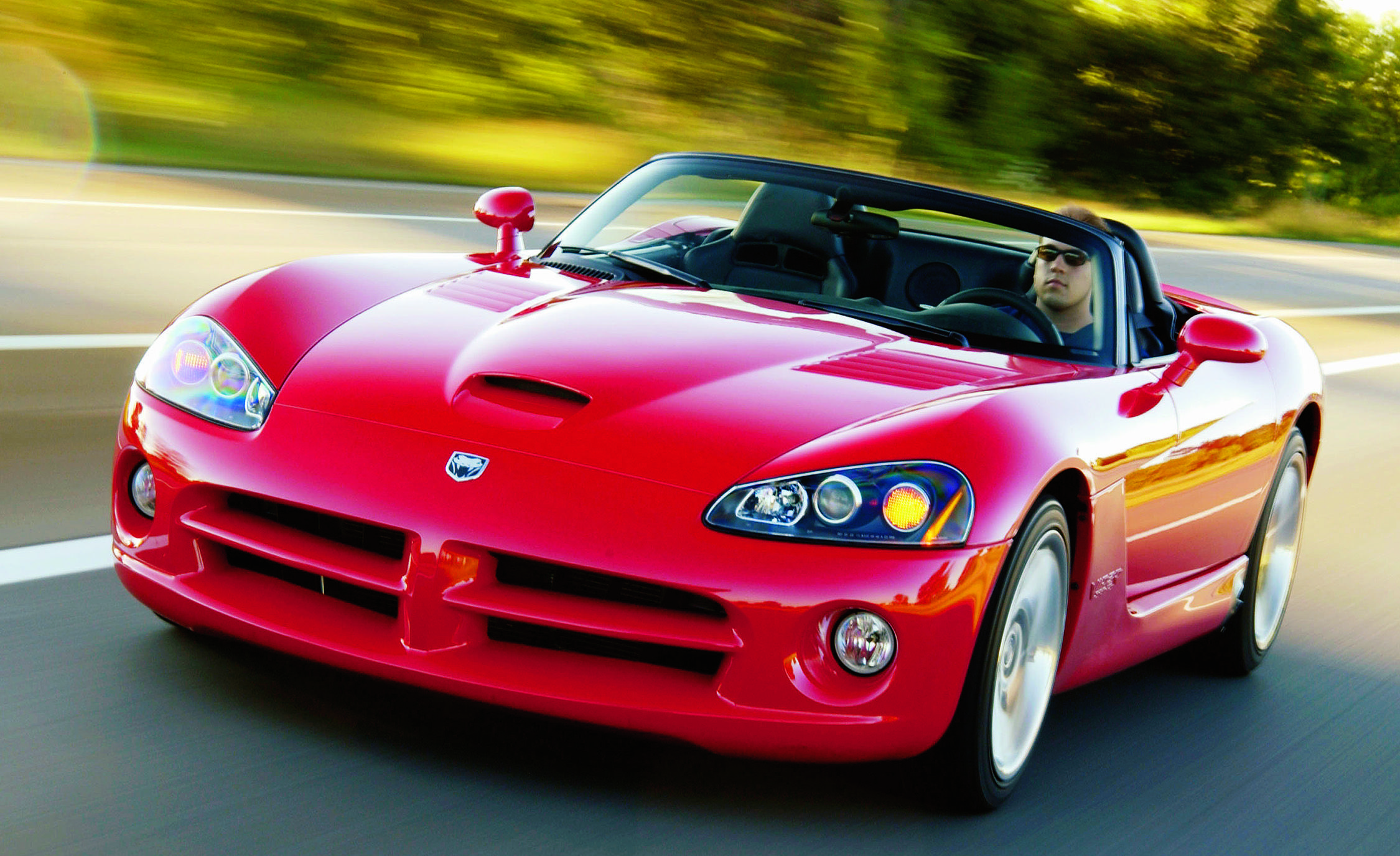
Aaron Kiley Car and Driver
10 of 22
Viper, Part Deux
The next-generation Viper arrives for the 2003 model year with a new 500-hp 8.3-liter V-10 in place of its predecessor’s 8.0-liter unit. A six-speed manual is again the only available transmission. Post-redesign, the Viper’s coupe version goes on hiatus, and the open-top model gains a proper folding soft top (as opposed to the flimsy targa/bikini-top thing the first-gen car endured). In our first test of an SRT10, we record a 12.1-second quarter-mile time with a trap speed of 121 mph.
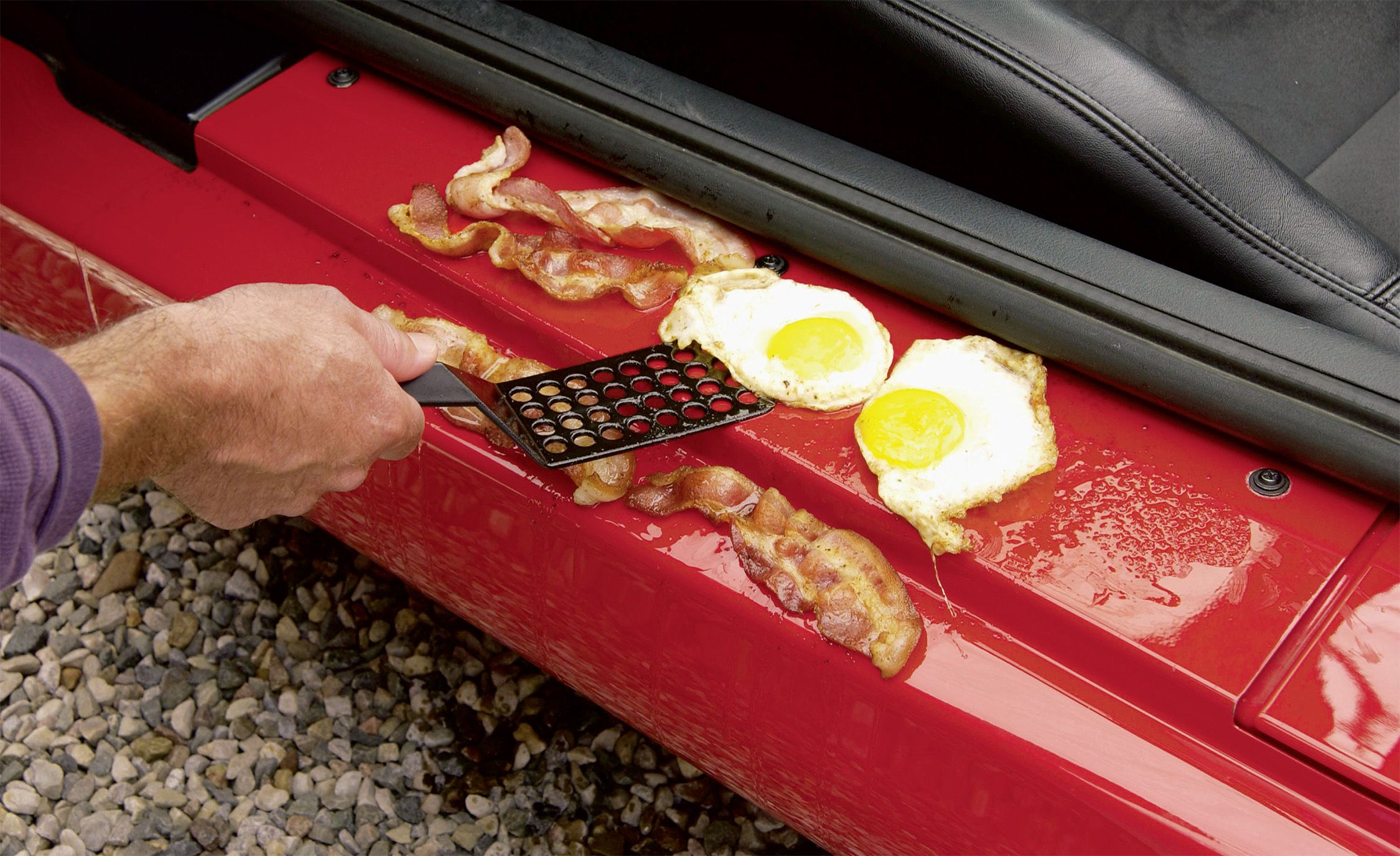
Aaron Kiley Car and Driver
11 of 22
Makin’ Bacon
Nearly as critical as the Viper’s performance? Chrysler finds a way to bring back the original’s side-exit exhausts. We test their scorching power by cooking some bacon and eggs on the doorsills.
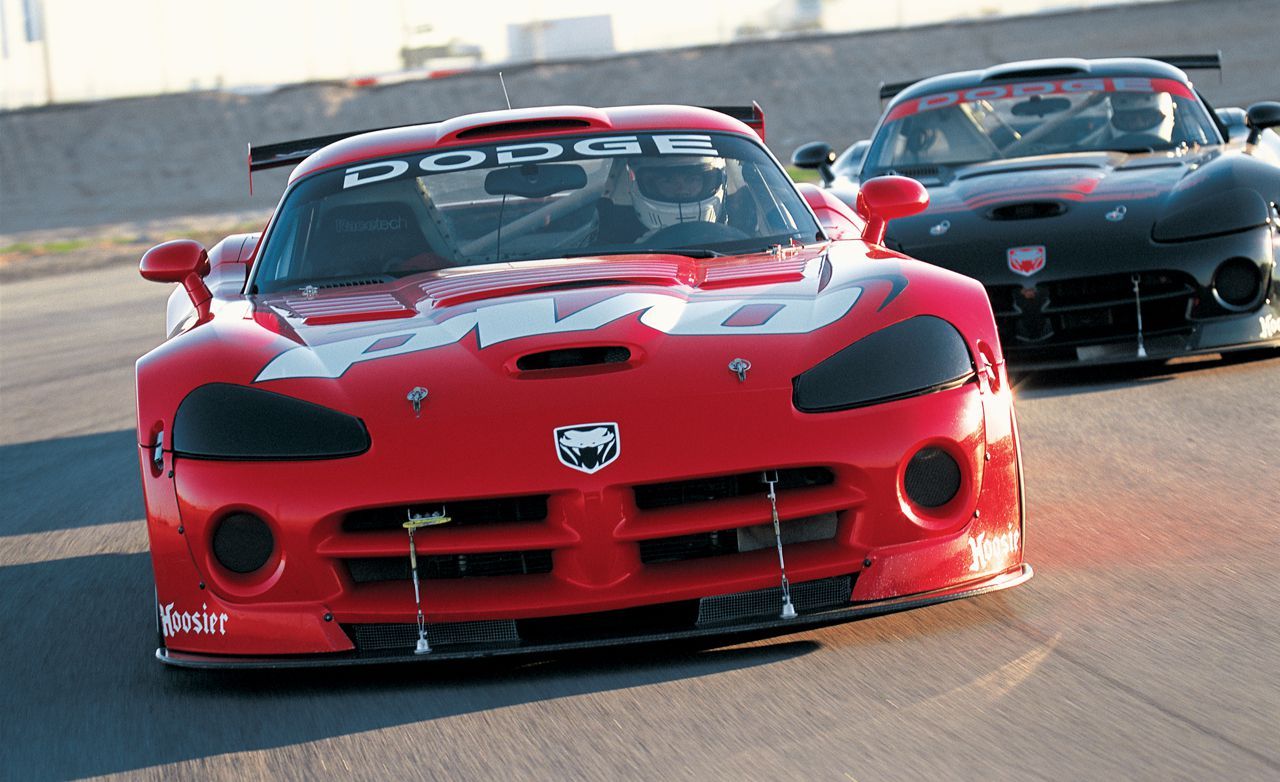
12 of 22
Racing Is Life—Anything Before or After Is just Waiting
Racing is as much a part of the Viper’s legacy as its V-10 engine, and to celebrate that reality, Dodge introduces the track-only Viper Competition Coupe for 2003. Although its body style differs from that of its street-legal sibling, the Viper Competition Coupe shares most of the roadgoing car’s key mechanical components, including the 8.3-liter V-10. Free from emissions regulations, however, the Competition Coupe lacks catalysts and benefits from a retuned engine computer, a hotter camshaft, and a smaller crankshaft pulley. The result is 520 horsepower—20 more than the street car.
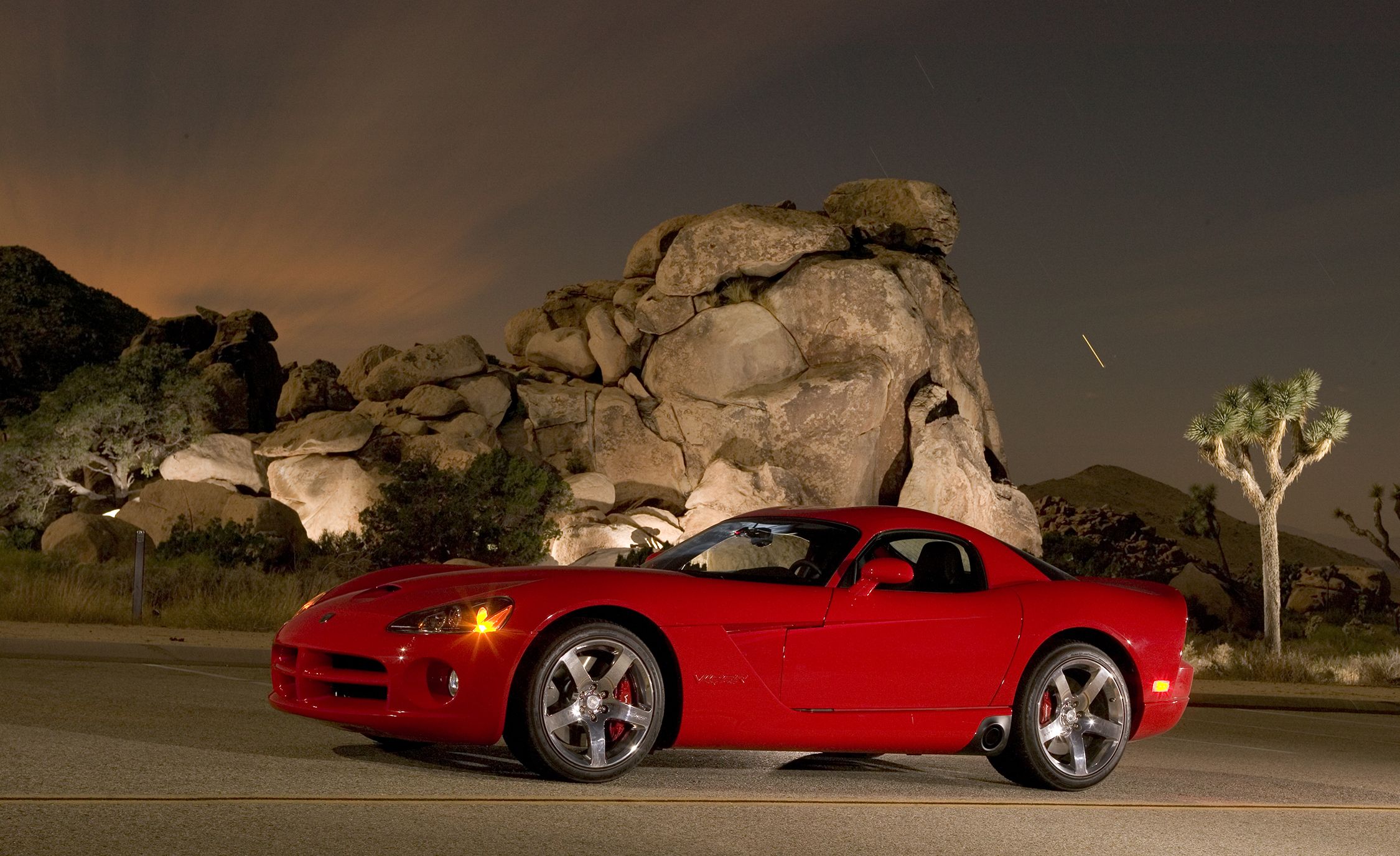
Road & Track / Jeff AllenCar and Driver
13 of 22
Couped Up
The coupe returns to the roadgoing Viper lineup for 2006. No longer called GTS, the tin-topped model retains the soft top’s 500-hp 8.3-liter V-10. Structural rigidity is improved as well, although the double-bubble roof (so-called for its dual humps over the front seats) adds a few pounds to the car’s curb weight relative to its convertible sibling.

Rich Chenet Car and Driver
14 of 22
Firepower!
The smallest changes can have rather large effects. In updating the Viper for 2008, Dodge increases the V-10’s cylinder bore by one millimeter, bumping displacement to 8.4 liters and upping output to a rowdy 600 horsepower. Changes to the suspension are implemented in the hopes of taming the Viper’s limit-handling behavior and making it easier to drive. Cosmetically, the 2008 Viper wears new wheel designs and revised hood vents.
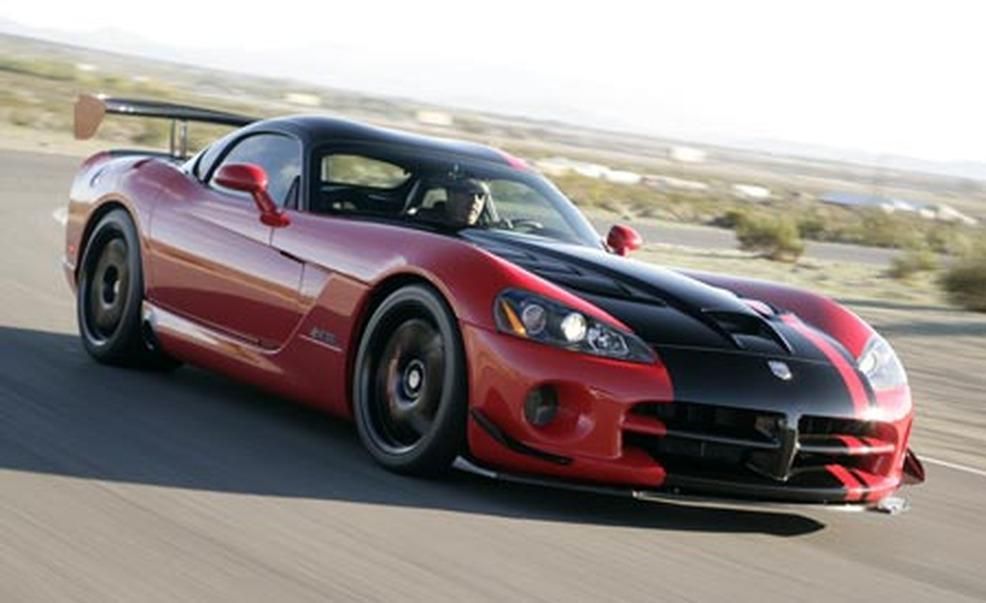
15 of 22
ACR 360
The Viper ACR returns! Taking a page from the Lotus playbook, Dodge guts 40 pounds from the Viper coupe and leaves the 600-hp 8.4-liter V-10 untouched. Accompanying the 2008 ACR’s weight loss are a host of aerodynamic upgrades, including a massive rear wing and a chunky front splitter. At our annual Lightning Lap event, an ACR lays down a blistering 2:48.6 lap of Virginia International Raceway (VIR), second only to that of a Mosler MT900S.
A more powerful, track-only Viper ACR-X is introduced in 2010, while updates to the street-legal 2010 Viper ACR include a new short-throw shifter, a numerically higher fifth-gear ratio, and revisions to the wing to limit drag while maximizing downforce. The extra downforce, by the way, actually makes the extreme-looking ACR more docile and easier to drive fast on track than regular Vipers.
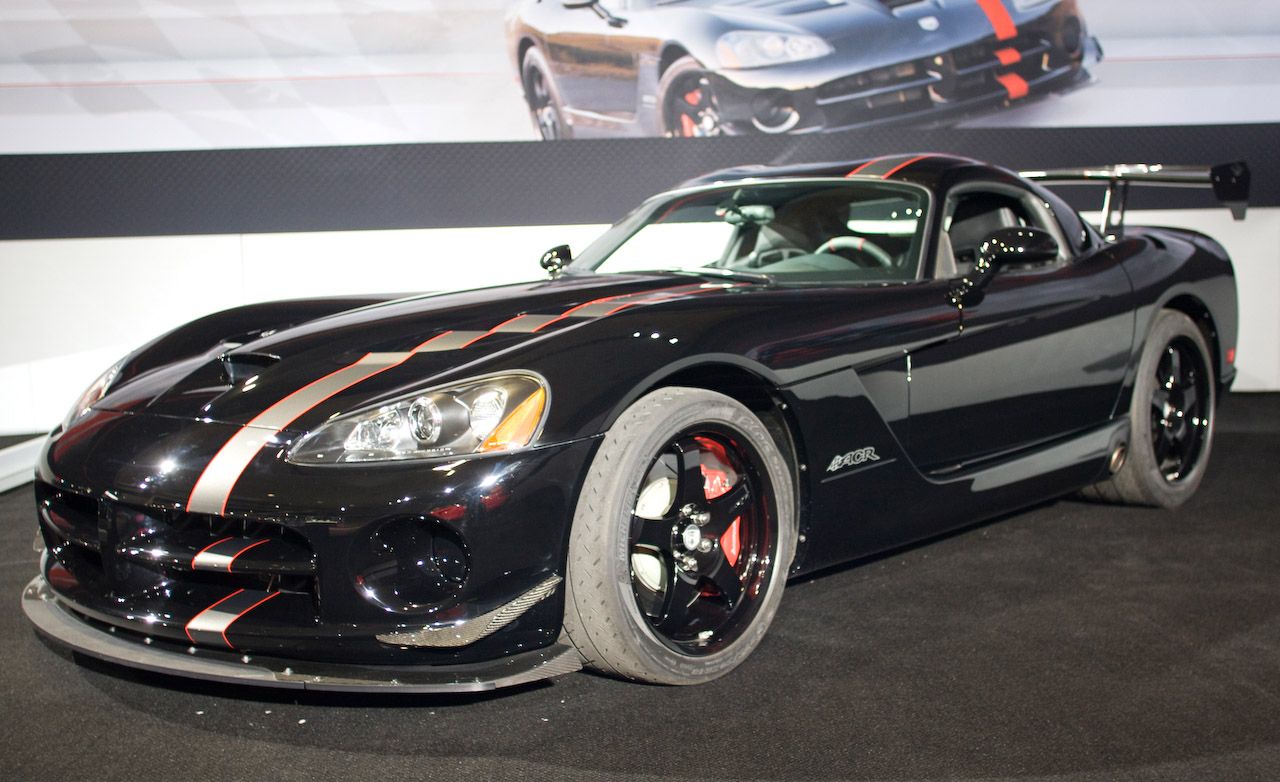
Forest Casey Car and Driver
16 of 22
RIP?
Dodge ends production of the Viper, and 2010 is the final model year for this generation. The move is celebrated with a trio of limited-edition models: the Voodoo Edition (shown above), the 1:33 Edition, and the Final Edition. The Voodoo and 1:33 are takes on the hard-core ACR model, and Dodge builds 31 of the former and 33 of the latter. Meanwhile, the Final Edition kit graces 20 Viper coupes, 18 convertibles, and 12 ACRs.
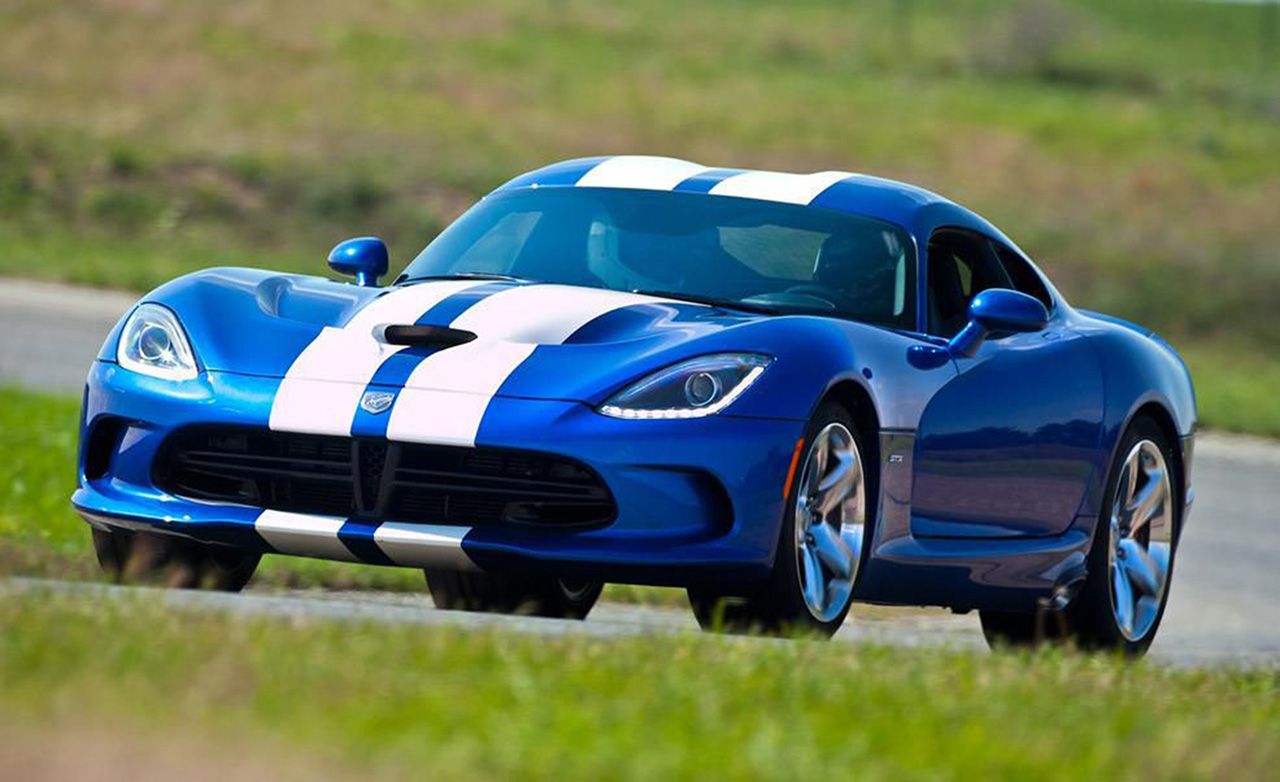
17 of 22
Ride the Snake
Following a brief hiatus, the Viper is completely redesigned and returns for 2013, although it no longer is a Dodge. Instead, the Viper now wears SRT branding and serves as the halo vehicle for Chrysler’s Street and Racing Technology (SRT) performance division. Strictly offered as a coupe, this iteration of the Viper retains the prior car’s 8.4-liter V-10 and aggressive front-engine, rear-drive proportions. Designer (and then head of the Dodge brand) Ralph Gilles is said to liken his curvy creation, visually, to a woman lying naked on a beach. True or not, the Viper’s undulating fenders are borderline sexual.
The car’s vibe retains a distinct whiff of danger, by now a Viper signature, although for the first time it has stability control. SRT is adamant that it added the feature only because pesky automotive-safety regulations forced its hand and, to prove it, provides an easy-to-find button for disabling the electronic safety net.
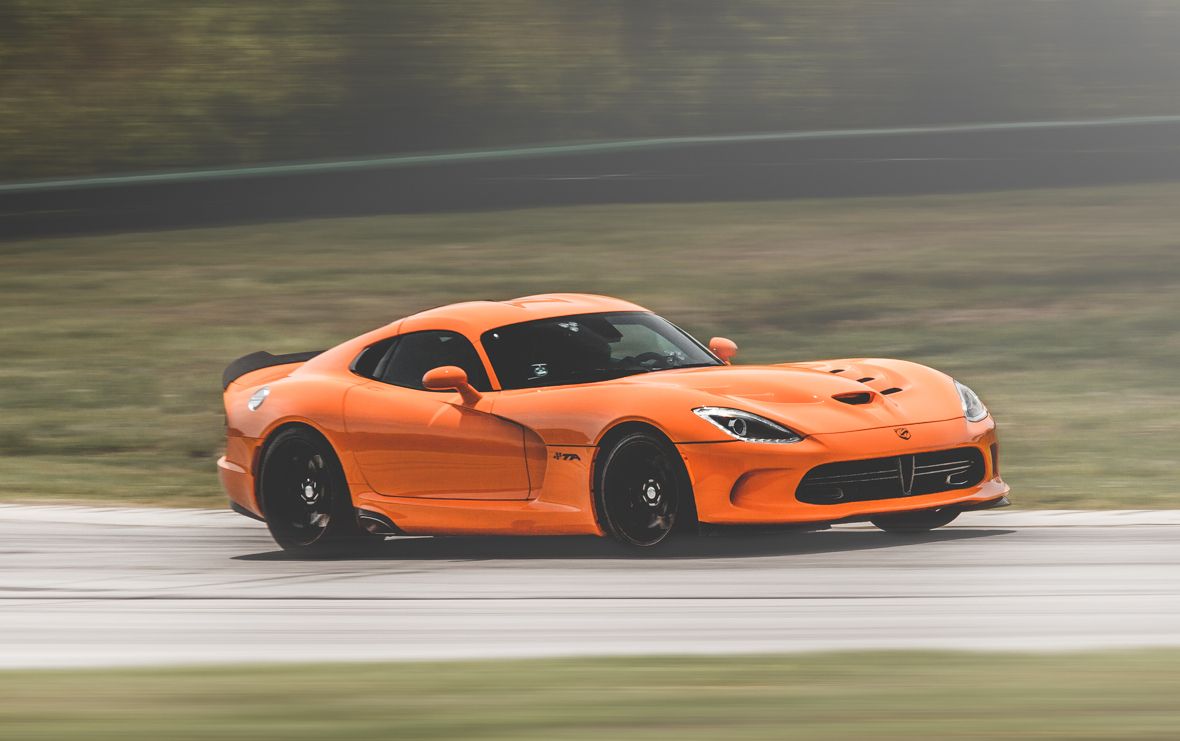
18 of 22
Track Attacker
The track remains the Viper’s home, and for 2014 SRT releases the Viper TA(for Time Attack). The $120,480 TA ($16,000 more than a standard SRT Viper) includes extra-sticky Pirelli P Zero Corsa tires, a pair of front-mounted carbon-fiber splitters, stiffer anti-roll bars, higher camber alignment, revised brakes, and a carbon-fiber rear spoiler and engine brace.
We take a Viper TA to Lightning Lap and record a 2:49.9 lap around VIR. The Viper’s lap is the third-quickest that year, behind only the Nissan GT-R NISMO(2:49.4) and the Porsche 918 Spyder(2:43.1).
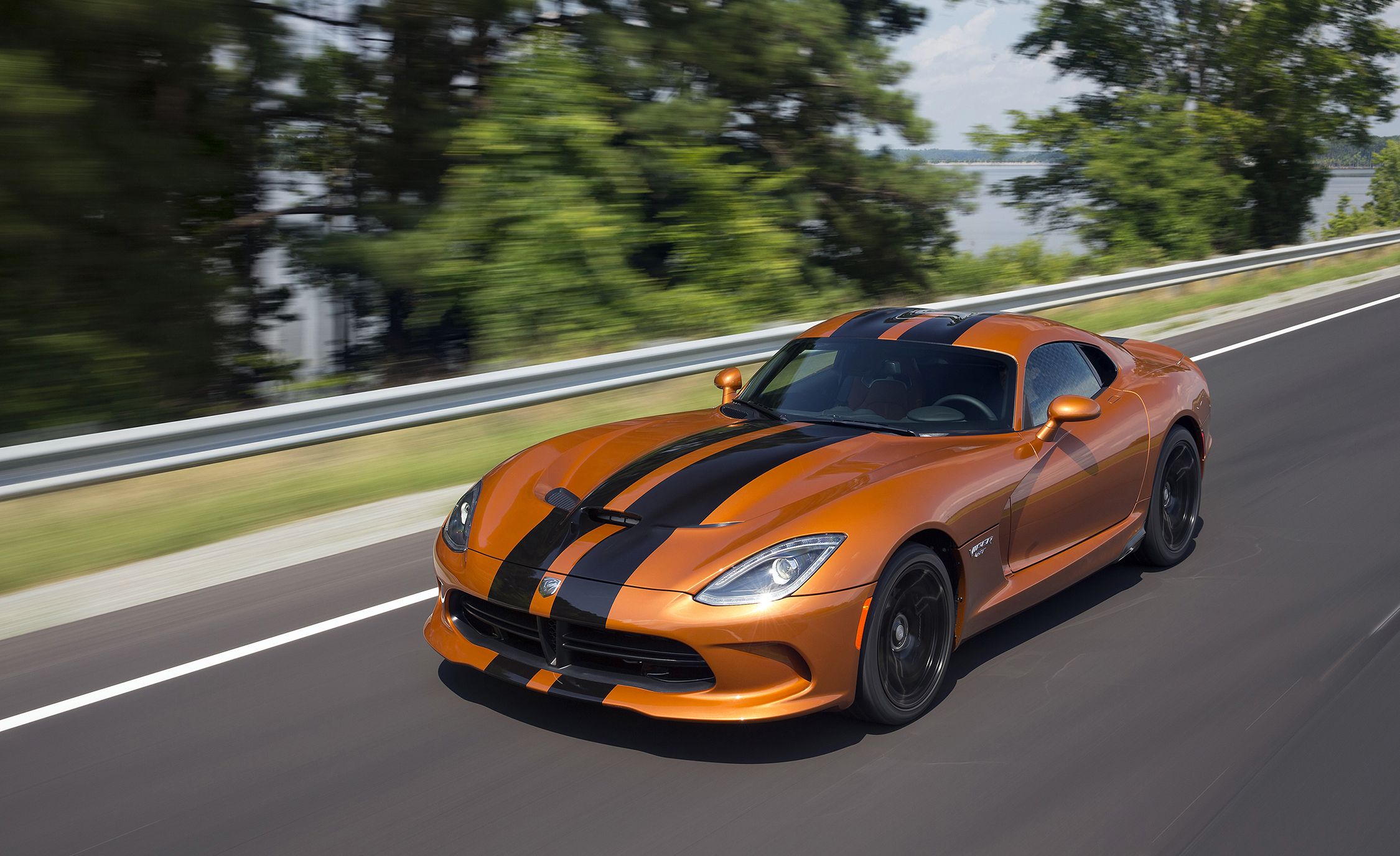
19 of 22
That’s One Dodgy Snake
The Viper once again lives beneath the Dodge banner, returning to the brand for the 2015 model year. The homecoming includes a handful of trim changes and revisions to the V-10 engine, whose output is now a substantial 645 horsepower. One year later, Dodge reintroduces the hard-core Viper ACR trim; the automaker claims that the ACR’s available Extreme Aero package helps the car generate more than 1500 pounds of downforce at its 177-mph top speed.
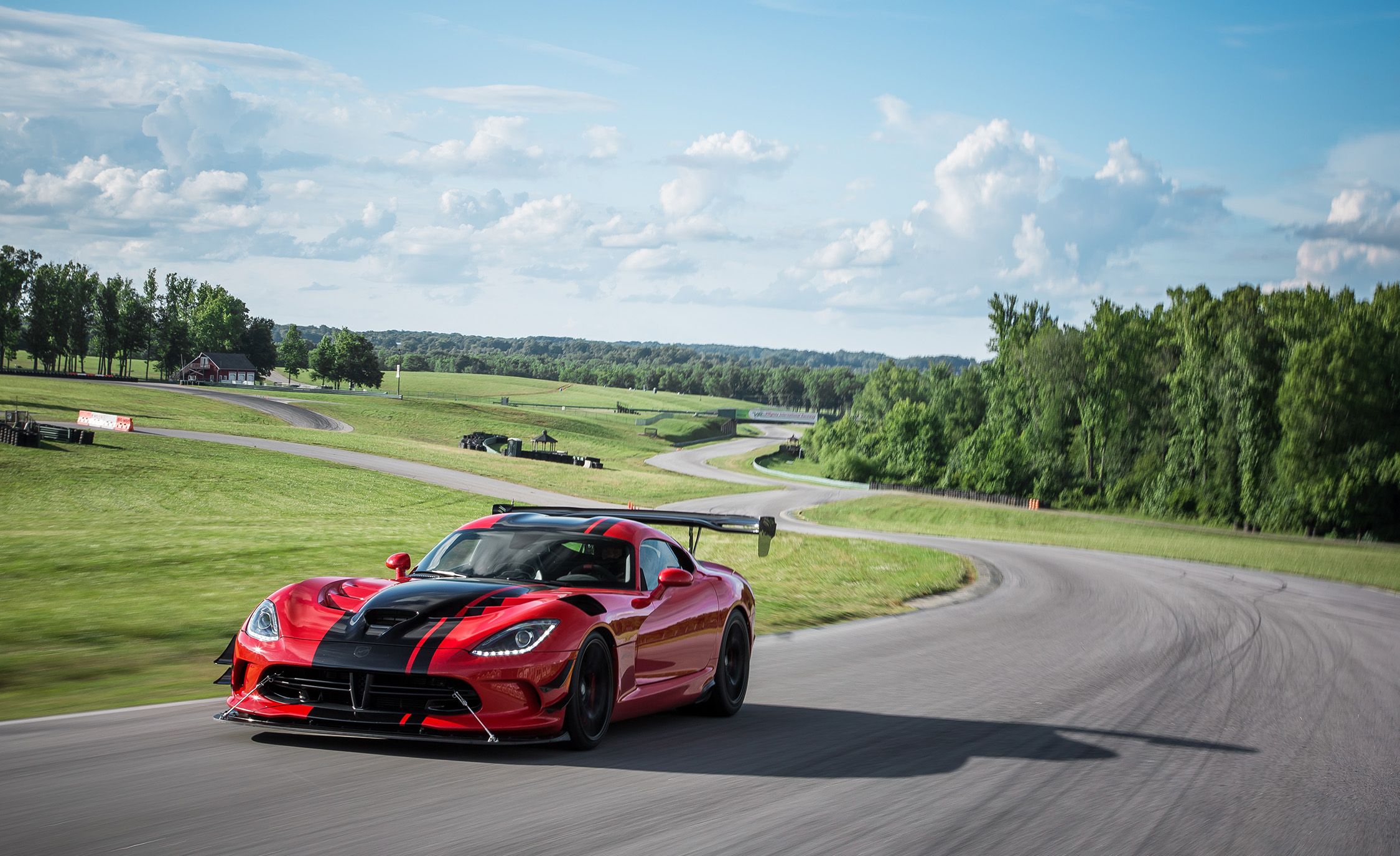
Michael Simari Car and Driver
20 of 22
Lightning Strikes Again
At Lightning Lap 2016,a Viper ACR circles VIR’s Grand Course configuration in 2:44.2. The time is the best of the event and remains among the top-five Lightning Lap times we’ve recorded through 2017.
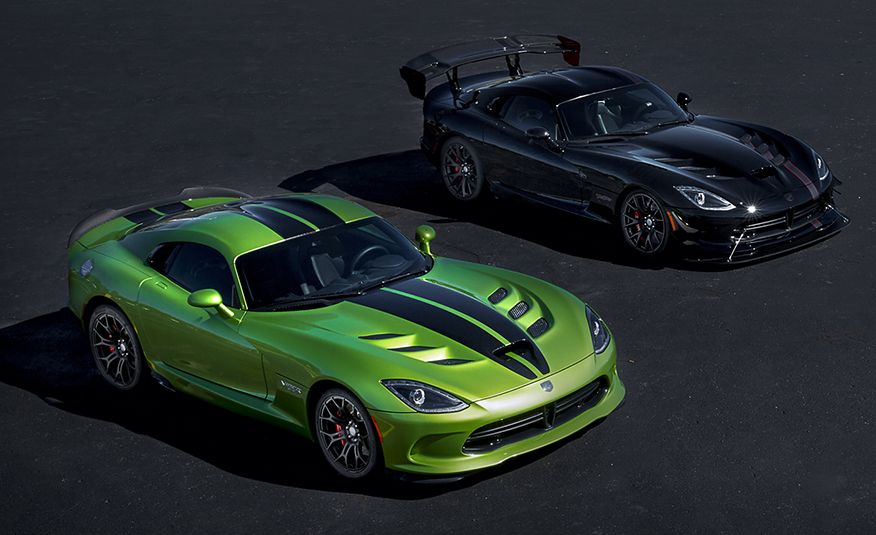
21of 22
Dead and Gone?
For all the Viper’s awesomeness, its longtime sales slump drives Dodge to formally kill off the model in 2017.A number of special-edition models are crafted in memoriam, including the Snakeskin Edition, the Snakeskin Edition ACR, the Dodge Dealer Edition, the GTS-R Commemorative Edition, the Voo Doo II Edition, and the 1:28 Edition. The Snakeskin is the only special-edition Viper of these that’s not based on the Viper ACR.
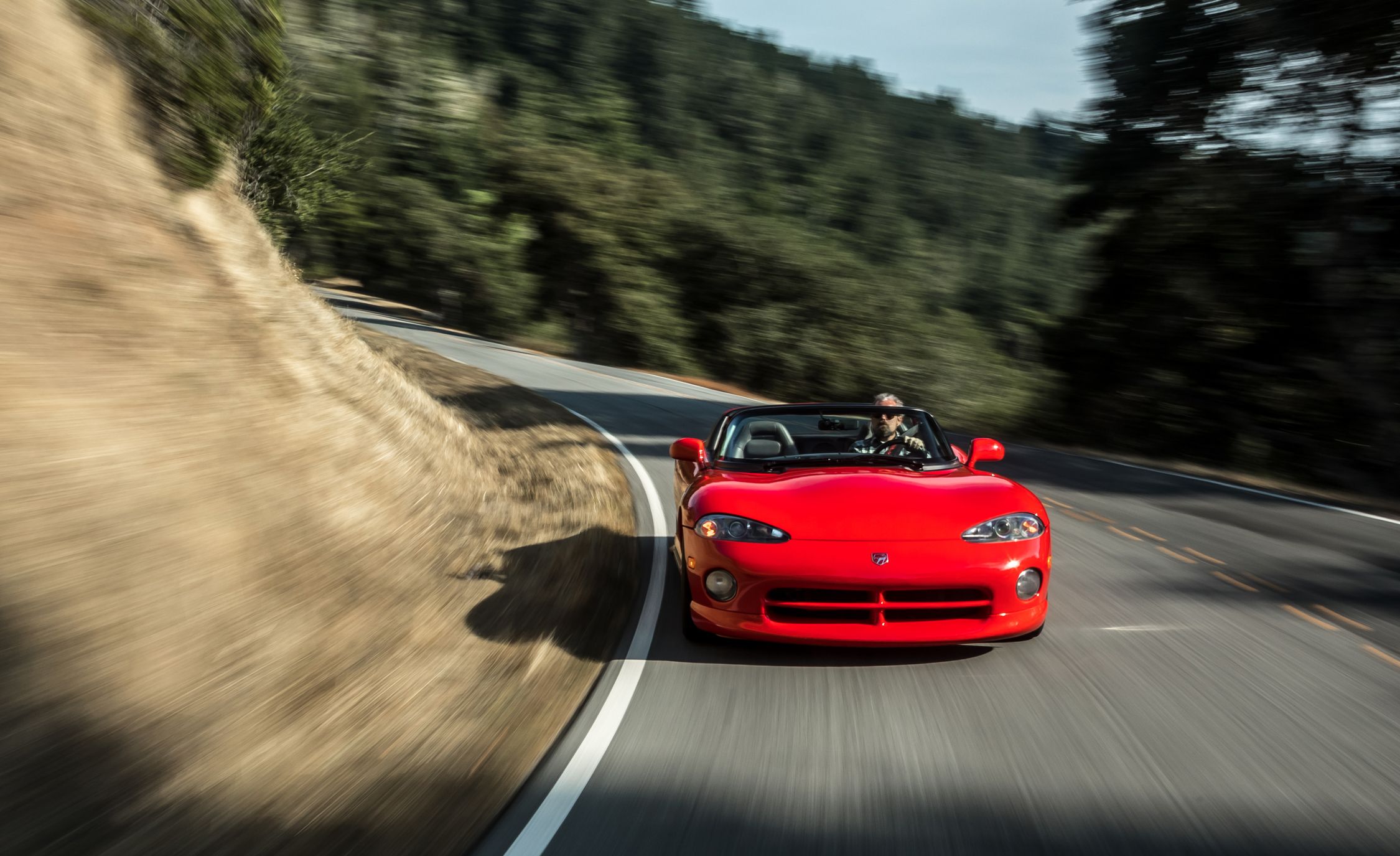
Marc Urbano Car and Driver
22of 22
Will It Slither Again?
With the burden of Viper production lifted from the Conner Avenue Assembly Plant in Detroit, Michigan, Fiat Chrysler Automobiles opts to turn the facility into a home for its collection of historic cars. The move, which strips the Viper of its most obvious assembly facility, seemingly puts the kibosh on the Viper’s future. Even so, the sports car seems ripe for resurrection, and FCA CEO Sergio Marchionne expresses hope that the model could yet return. If, or when, the Viper returns, expect FCA to contract out the construction of the vehicle to an outside supplier. Regardless of who ultimately builds the sporty machine, should it happen, don’t expect it to go soft or lack rawness. It wouldn’t be a Viper if it did.

